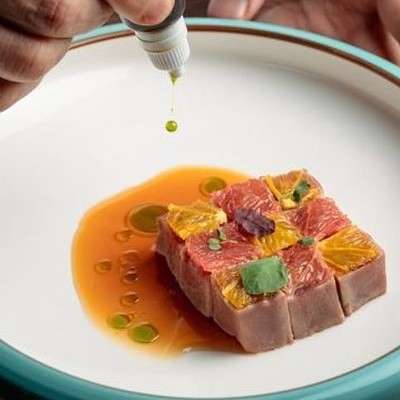"A sushi chef may train for 10 years. There is only one thing he needs to know: fish. But a kaiseki chef trains for at least 20 years," Kubo's newly installed executive chef, Kiyoka Ito, explained in brusque Japanese, as owner Yoichi Ueno (Yogi-san to his friends) translated for us at last night's media dinner.
That 20-year training period came as no surprise after we were finished with the eight-course meal, which wasn't so much a succession of dishes as it was a journey through the freshest flavors of springtime as interpreted by a master. At one point, Jenny Wang of Southbound Food pulled out her phone to show Chef Ito a photo of "Kaiseki King" Yoshihiro Murata. "Do you know Murata?" she asked the chef. Ito nodded knowingly, a trace of a smile on his face as if to say, "Yes, but I'm just as good."
Everything about the meal surprised me, from the quality of the ingredients to the carefully planned presentation, which was an art form in and of itself. Fiddlehead ferns were tightly coiled like sleeping lizards in a landscape that also contained thick slices of savory ankimo, rendered bright orange with luscious fat, alongside pert rolls of thinly sliced prosciutto filled with a Japanese shoot called taranome, which was delicious enough to make me rethink ever filling prosciutto with asparagus again. And that was just the first course.
Kaiseki dinners are designed to take diners on a tightly focused trip through the best foods available on that particular day, in that particular season. Every kaiseki dinner features at least eight courses: an appetizer, a soup, sashimi, a steamed dish, a grilled dish, a fried dish, a rice dish (sushi, in this case) and a dessert. Kubo's is the first restaurant in Houston to offer authentic kaiseki dinners, which are wholly different from omakase not only in their carefully orchestrated design but also in price and availability.
While omakase is a more casual meal, wherein the chef prepares the best of what he has on hand that day, kaiseki dinners must be planned at least a week in advance. This gives Chef Ito enough time to special-order all of his ingredients, which Yogi-san picks up at the airport the day before the meal. (Yes, most everything Chef Ito currently uses comes from Japan, as he admitted he hasn't found any American ingredients he likes or that come close to his standards. Although concentrated on the freshest flavors of the season, this is hardly a farm-to-table-style meal.)
Each course features only the finest iteration of each ingredient -- not just salmon in the sashimi course, but the lightly colored, fatty belly of the salmon; not just regular beef in the griled course, but a Kobe ribeye. These considerations, as well as the hours it takes Chef Ito to prepare the meal, mean that a kaiseki dinner starts at $100 per person. The dinner serves a maximum of six people -- no more -- and can only be offered once per day.
If $100 is a bit steep for you, take heart: Kubo's will soon be offering a mini kaiseki lunch. With a reduced price (and a reduced number of courses), it's an affordable way to experience the centuries-old kaseki technique without leaving your wallet in shreds.
As Chef Ito spoke after dinner about the years of rigid training and apprenticeship that goes into becoming a kaiseki chef, I couldn't help but reflect on the similarities between the Japanese culinary culture and that of the French: technique-driven, with emphasis on learning every aspect of food preparation over the years, from a lowly third commis up to a trusted saucier, before one could truly begin to introduce his or her own style and personality into a dish. And while we have many truly excellent French restaurants in Houston, we're only now beginning to get equally high-quality (and authentic) Japanese restaurants as well.
Kaiseki is finally catching on in America, where Los Angeles restaurants like Urasawa are offering the dinner for just under $300 a person. Yet another reason to thank your lucky stars you live in Texas.





